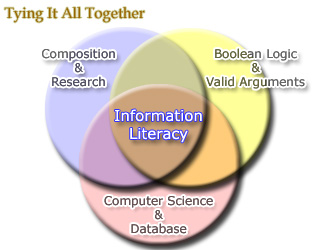By R. Glass and M. Spiegelman
In an all too familiar scenario, a faculty member schedules a library session for students to gain experience with library resources and research techniques. The students are confronted with a lecture on research tools, search techniques, formats, databases, and catalogs. A few of the students retain part of the information, but for others, it is soon forgotten because information not reinforced is often lost. From the students’ perspective, the librarian becomes just another member of the campus rather than a resource, a mentor, a teacher, someone who can be sought out when questions arise. Some students will return to the librarian for assistance with future projects while many will struggle with Google and cite questionable sources.
Boolean logic has long (since the computer) been the main-stay of both high school and college curricula. Often students fail to see the logic of studying such. “Where will I ever need this?” they ask. The current curricula lack the real-world application of the rows of truth tables, laws and equivalencies and without practice and motivation to re-enforce the properties and students soon forget all they learn.

The goal here was to provide the missing link, to join together the practical research techniques needed with the abstract mathematical theory and present it in a formal Information Literacy setting. That missing link is the Computer Science area of database access that incorporates the underlying logical operators, and, or and not along with their set theory equivalences union, intersection and complement. These operators are what one uses to retrieve the information from a database.
After the learning the basics of Boolean algebra, an Information Literacy session is scheduled with the library and the students are introduced to the databases. An assignment consisting of research topics / terms that one might find in a GLA course is presented. These terms are presented using the formal structure of Boolean algebra. Since students have been introduced to the simple (statements that are true or false) and compound statements (simple statements connected with Boolean operators they only need to translate and apply them to the database. They are then asked to compare the number of hits they obtained when formulate the queries in database syntax. For example, if d = death and p = penalty, the students are asked to determine the hits for d /\ p (where /\ is the notation for and in the mathematical setting). They submit queries such as death and penalty along with death penalty and are asked compare the results to the simple statement “death penalty” Future assignments will ask the student to re-write queries using equivalent laws such as DeMorgans Law. Other assignments stress the importance of parenthesis and precedence of operators while others will ask the student to develop their own queries and write them in both the database syntax and formal mathematical structure.
Information is only useful when one can find and collate it. The students of today are faced with an exponential amount of information along with a growing access to it. Portals such as Google or Wikipedia allow anyone to retrieve and create information. A careless or non-precise query (or search) can easily return hits (or references) in numbers in excess of six digits. Still, this incentive falls short. Today, anyone with Internet access can add to Wikipedia. What was once only “Have server space? Then you too can create a web page expressing whatever opinion you have “ we now see blogs springing up everywhere. Who are these bloggers? Who are writing those feeds? What are the qualifications to be a guide on About.com (my students found out) or contribute to Wikipedia? This is not to say that these sites should not be trusted but rather the person of tomorrow must know not only how to find the information but to evaluate it and use it ethically.